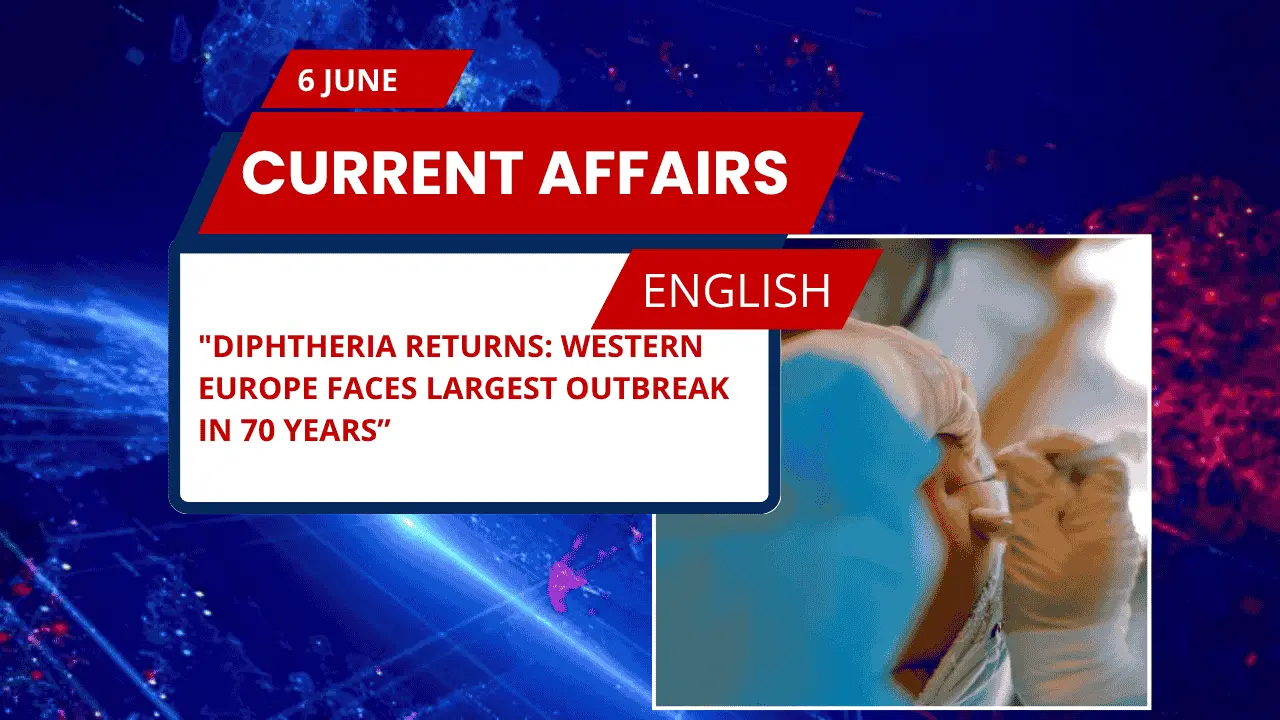
Key Points for SSC & Other Govt Exams
- Disease: Diphtheria – highly contagious bacterial infection
- Bacteria: Corynebacterium diphtheriae
- WHO Status: Classified as highly contagious with ~30% fatality rate in severe cases
- Affected Regions: Western Europe (especially since 2022)
- Vulnerable Groups: Migrants, homeless populations
- Cases Recorded: 536 cases since 2022, including 3 deaths
- Vaccination Gaps (2023): 16% of children globally unvaccinated or under-vaccinated
- Global Coverage: ~84% children received 3 doses during infancy
- Symptoms: Sore throat, fever, swollen neck, skin ulcers
- Complications: Can lead to heart and nerve damage
- Origin: Traced to migration journeys or shelters, not country of origin
WHO – Static GK for MCQs
World Health Organization (WHO)
- Founded: 1948
- Headquarters: Geneva, Switzerland
- Director-General: Dr. Tedros Adhanom Ghebreyesus
- Parent Organization: United Nations (UN)
- Role: Global health authority coordinating international public health efforts
Complete Blog Article
Diphtheria, a disease nearly eradicated through vaccination, has made an alarming return to Western Europe, marking the largest outbreak in over 70 years. This resurgence, beginning in 2022, has affected hundreds, especially migrants and homeless individuals, exposing cracks in public health coverage.
About Diphtheria
Diphtheria is an acute bacterial infection caused by Corynebacterium diphtheriae. It primarily impacts the respiratory tract, although it can also cause skin infections. The hallmark symptoms include sore throat, fever, swollen glands in the neck, and in severe cases, toxin-related heart and nerve damage. The fatality rate may reach 30% among the unvaccinated and untreated.
2022–2024 Outbreak Overview
In 2022, 362 cases were recorded across Europe. The total has since reached 536, with 3 confirmed deaths. The majority of cases involve young male migrants, particularly from Afghanistan and Syria. However, health experts clarified that the disease did not originate in these countries but likely spread during migration journeys or inside overcrowded shelters with limited vaccination access.
Why Vulnerable Populations Are at Risk
Migrants and homeless people have been hit hardest. Many lack access to routine immunisations, increasing their susceptibility. Genetic analysis of the bacterial strains has pointed to a common source, suggesting close-contact transmission in unhygienic and overcrowded environments.
Public Health Concerns
The outbreak has triggered concern over global immunisation practices. In 2023, about 16% of children worldwide were found unvaccinated or under-vaccinated. This lack of coverage weakens herd immunity, allowing diseases like diphtheria to re-emerge. Despite 84% global coverage for the recommended three doses, regional disparities remain a challenge.
The Role of Vaccination
Vaccination remains the most effective prevention. Booster shots and complete vaccine cycles in children are essential. Public health authorities are urging countries to enhance awareness, train healthcare professionals, and ensure vaccine availability, especially for mobile or displaced populations.
Long-Term Implications
This resurgence is a warning. Public health systems must not become complacent. Diphtheria, once considered a controlled disease, can return rapidly if vaccination rates drop. A renewed global focus on routine immunisation and outreach to vulnerable communities is urgently needed.
Potential Exam Questions
Q1. Diphtheria is caused by which of the following bacteria?
[A] Mycobacterium tuberculosis
[B] Corynebacterium diphtheriae
[C] Streptococcus pneumoniae
[D] Haemophilus influenzae
Correct Answer: [B] Corynebacterium diphtheriae
Q2. What is the approximate fatality rate of diphtheria in severe cases?
[A] 10%
[B] 20%
[C] 30%
[D] 50%
Correct Answer: [C] 30%
Q3. Which population group has been most affected by the diphtheria outbreak in Western Europe?
[A] Elderly people
[B] Migrants and the homeless
[C] School children
[D] Tourists
Correct Answer: [B] Migrants and the homeless
Q4. In 2023, what percentage of children worldwide were either unvaccinated or under-vaccinated against diphtheria?
[A] 8%
[B] 12%
[C] 16%
[D] 20%
Correct Answer: [C] 16%
Q5. The World Health Organization (WHO) is headquartered in which city?
[A] Paris
[B] Geneva
[C] New York
[D] Vienna
Correct Answer: [B] Geneva







